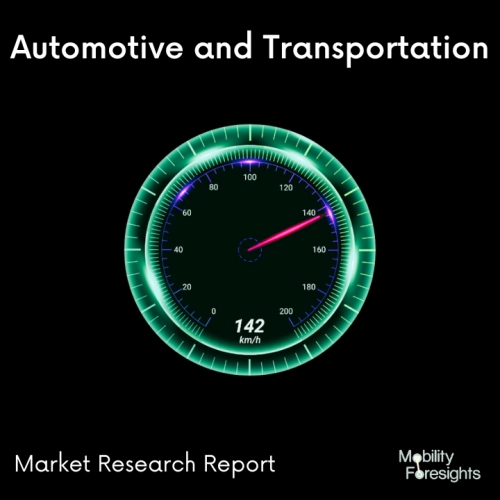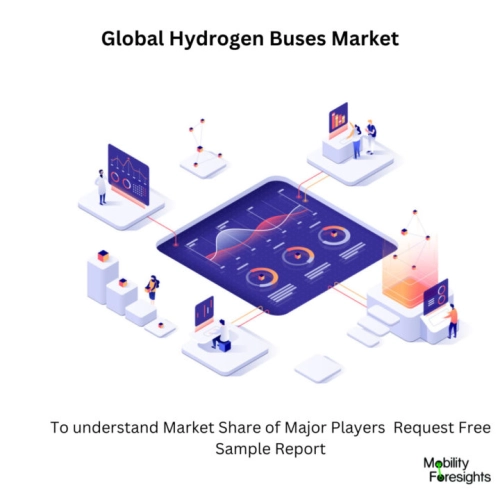
- Get in Touch with Us

Last Updated: Apr 25, 2025 | Study Period: 2023-2030
In addition to fuel cell buses and hydrogen fuel cell buses, hydrogen buses are a subcategory of public transportation vehicles that use hydrogen as their main fuel. They are a substitute for standard diesel or gasoline-powered buses and come with a number of benefits, such as lower greenhouse gas emissions and a decreased reliance on fossil fuels.
The hydrogen fuel cell is the main component of hydrogen buses. The only consequence of a fuel cell's electrochemical process, which turns hydrogen and oxygen into energy, is water. In the case of hydrogen buses, the fuel cells produce electricity by fusing oxygen from the air with hydrogen from onboard storage tanks.
The electric motor that moves the bus forward is powered by the electricity generated by the fuel cells. Fuel cell systems have high energy efficiency and operate quietly and smoothly. Additionally, compared to conventional buses, hydrogen buses greatly reduce air pollution due to the absence of exhaust emissions.Hydrogen buses provide a number of advantages:
Zero Emissions: Since water vapor is the only consequence of the fuel cell reaction, hydrogen buses have zero tailpipe emissions. As a result, they are a green transportation choice that lowers greenhouse gas emissions and air pollution, improving the quality of the air in metropolitan areas.
Energy Efficiency: Hydrogen fuel cell devices convert a significant amount of the chemical energy in hydrogen into usable electrical energy, resulting in excellent energy efficiency. Comparing these buses to more efficient ones, they get better mileage and use less fuel.
Integration of Renewable Energy: Electrolysis is a method that can manufacture hydrogen utilizing renewable energy sources like solar or wind energy. By combining the production of renewable energy with the production and consumption of hydrogen in buses, this enables the development of a sustainable energy environment.
Range and Refueling: Hydrogen buses can travel farther and refuel faster than regular buses, which overcomes some of the drawbacks of battery-powered vehicles. They are suitable for public transportation routes with high mileage needs because they can go great distances and can be refueled quite quickly.
Noise reduction: Since hydrogen buses don't have internal combustion engines, they run quietly. This noise reduction makes cities more aesthetically pleasing and the transportation system quieter.
But there are a few difficulties with hydrogen buses:Infrastructure Development: The establishment of a hydrogen refueling infrastructure is one of the major obstacles. For the use of hydrogen buses to be widely adopted, hydrogen recharging stations must be built. Significant financial investment and cooperation amongst numerous parties are needed for infrastructure development.
Cost: Compared to regular diesel or natural gas buses, hydrogen buses now have a higher initial cost. The cost is anticipated to go down over time as technology develops and economies of scale are attained through expanded production and deployment.
Production and Distribution of Hydrogen: To assure a consistent and long-lasting hydrogen supply, it is necessary to improve hydrogen production processes and distribution systems. To maximize the environmental advantages, the generation of hydrogen should increasingly move toward renewable energy sources.
Despite these difficulties, hydrogen buses show promise as a green and emission-free public transportation option. They've been put into use in a number of locations across the globe as part of initiatives to lower carbon emissions and enhance urban air quality.
The adoption of hydrogen buses can be hastened by additional developments in hydrogen technology, infrastructure building, and legislative backing, all of which will help create a more sustainable transportation system.

The Global Hydrogen Buses Market accounted for $XX Billion in 2022 and is anticipated to reach $XX Billion by 2030, registering a CAGR of XX% from 2023 to 2030.
Michael Wood, the transport minister, and Phil Goff, the mayor of Auckland, formally unveiled New Zealand's first hydrogen fuel cell bus at Ports of Auckland. The bus that offers operators a long-range, quick recharging, and zero emissions option was created and built by Global Bus Ventures, which is proud of its accomplishments.
Dr. Jitendra Singh, Union Minister of State, debuted the country's first hydrogen fuel cell bus in Pune, which was created by KPIT-CSIR. According to the minister, "Hydrogen Vision" is crucial for India to ensure that Atma Nirbhar implies inexpensive and accessible clean energy, achieving climate change targets, and fostering new businesses and employment.
Fuel cell buses and trucks have lower operating costs per kilometer than diesel-powered vehicles thanks to their great fuel efficiency and the high energy density of hydrogen, which could revolutionize India's freight industry. According to the minister, hydrogen-fueled vehicles offer a great way to get rid of the on-road pollutants from this industry. He continued by saying that India wants to enhance the number of inland rivers for shipping goods and people.
The Italian business Rampini Hydron introduces the Sixtron and Eltron as well as the first H2-powered 8-meter bus in Europe. Rampini created and designed the first hydrogen bus entirely made in Italy as well as the first 8-meter fuel cell bus in Europe.
At the production facility in Passignano sul Trasimeno, the new hydrogen fuel cell-powered Rampini Hydron was unveiled to representatives of the press and government today. Rampini Hydron is an 8-meter-long hydrogen bus with a reported range of 450 kilometers that can carry up to 48 passengers. Rampini Hydron combines a fuel cell that powers a high-performance battery. The car has a rear-wheel-drive electric motor with a 230kW maximum power output.
| 1 | Market Segmentation |
| 2 | Scope of the report |
| 3 | Abbreviations |
| 4 | Research Methodology |
| 5 | Executive Summary |
| 6 | Introduction |
| 7 | Insights from Industry stakeholders |
| 8 | Cost breakdown of Product by sub-components and average profit margin |
| 9 | Disruptive innovation in the Industry |
| 10 | Technology trends in the Industry |
| 11 | Consumer trends in the industry |
| 12 | Recent Production Milestones |
| 13 | Component Manufacturing in US, EU and China |
| 14 | COVID-19 impact on overall market |
| 15 | COVID-19 impact on Production of components |
| 16 | COVID-19 impact on Point of sale |
| 17 | Market Segmentation, Dynamics and Forecast by Geography, 2023-2030 |
| 18 | Market Segmentation, Dynamics and Forecast by Product Type, 2023-2030 |
| 19 | Market Segmentation, Dynamics and Forecast by Application, 2023-2030 |
| 20 | Market Segmentation, Dynamics and Forecast by End use, 2023-2030 |
| 21 | Product installation rate by OEM, 2023 |
| 22 | Incline/Decline in Average B-2-B selling price in past 5 years |
| 23 | Competition from substitute products |
| 24 | Gross margin and average profitability of suppliers |
| 25 | New product development in past 12 months |
| 26 | M&A in past 12 months |
| 27 | Growth strategy of leading players |
| 28 | Market share of vendors, 2023 |
| 29 | Company Profiles |
| 30 | Unmet needs and opportunity for new suppliers |
| 31 | Conclusion |
| 32 | Appendix |